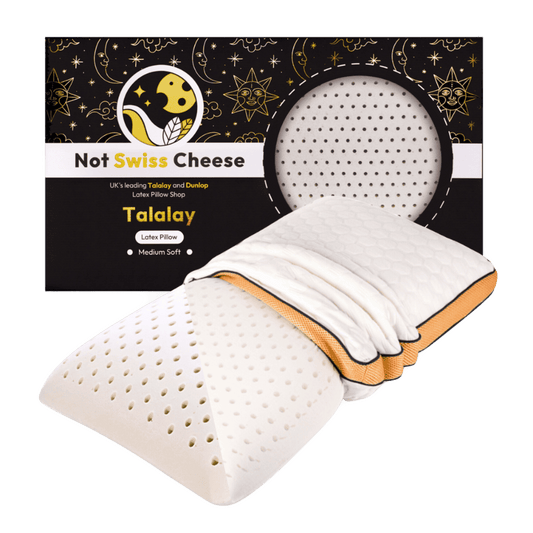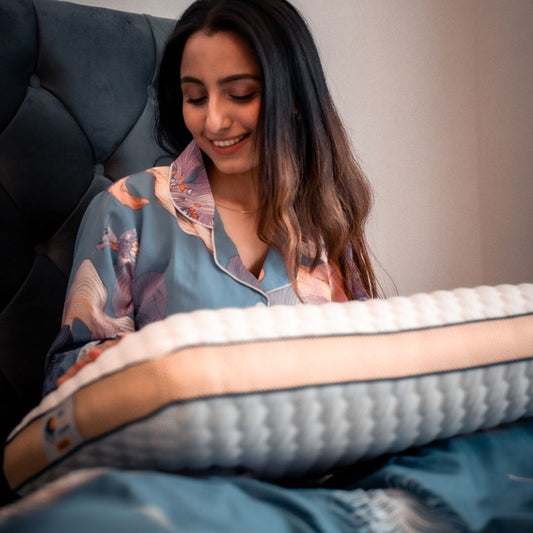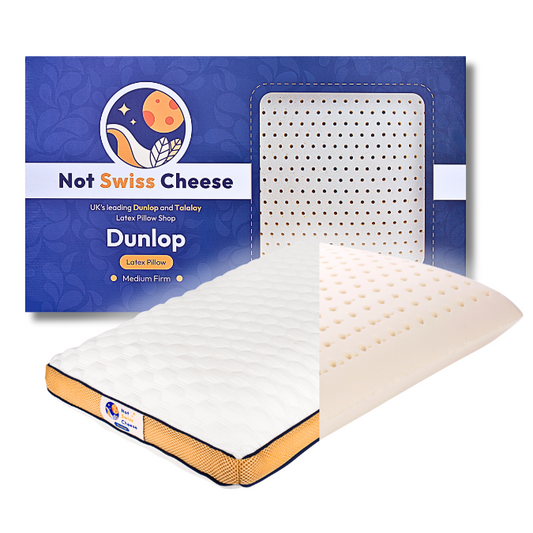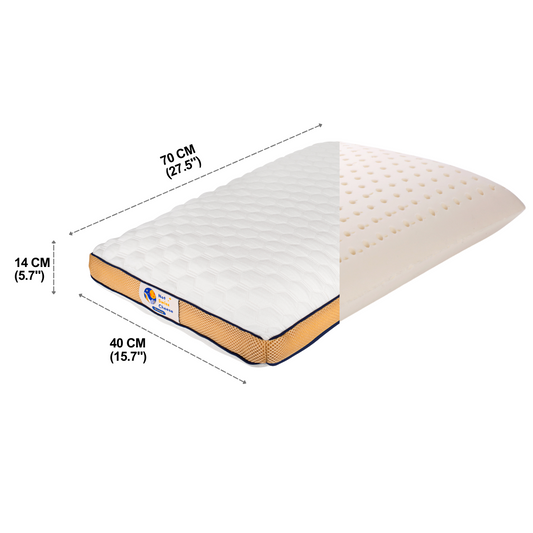Recovering after exercise is just as important as the workout itself. Your muscles repair and grow during rest, making recovery essential for strength and performance. Here's what you need to know:
- Sleep Matters: Deep sleep boosts human growth hormone (HGH) production, essential for muscle repair.
- Spinal Alignment: Proper sleep posture reduces tension and aids recovery. Back and side sleeping are ideal.
- Pillow Choice: Natural latex pillows, like Talalay and Dunlop, support spinal alignment, improve airflow, and last longer than traditional options.
- Temperature Control: A cool sleep environment (60–67°F) promotes better recovery.
Quick Comparison of Latex Pillow Types
| Feature | Talalay Latex | Dunlop Latex |
|---|---|---|
| Support Level | Medium-soft, bouncy | Medium-firm, dense |
| Durability | 10–15 years | 20–25 years |
| Temperature | More breathable | Retains warmth |
| Best For | General recovery | Intense training |
Invest in quality sleep and proper recovery tools to maximize your fitness results.
How to Choose and Use the Perfect Pillow for Better Sleep and Recovery
Sleep Position and Recovery
The way you sleep can have a direct effect on how well your muscles recover. Studies show that keeping your spine properly aligned while sleeping is key to helping muscles repair and reducing tension.
Correct Spine Position
Spinal alignment during sleep plays a big role in muscle recovery. The National Spine Health Foundation explains, "The key to sleeping well is to keep your spine naturally aligned." For example, when you sleep on your back, your spine bears about 50 pounds of pressure. To ease this stress:
- Back sleeping: Supports the spine's natural curve.
- Side sleeping: About 60% of people sleep on their sides. Keeping your body and legs straight in this position can improve blood flow to healing muscles.
"Your goal should be to find a neutral posture when you sleep so those ligaments that stretched out during the day can shrink and creep back to their normal position. Let your body truly rest and recover".
Reducing Pressure Points
Adjusting your sleep posture not only keeps your spine in alignment but also helps reduce pressure points. Physical therapist Jerry Yoo from Next Level Physio highlights, "When we sleep, hormones like HGH and testosterone (in males AND females) are secreted by the pituitary gland to promote muscle recovery. When our sleep is interrupted, especially non-REM sleep, we shunt the optimized benefit from sleep".
Here are some tips to ease pressure on your spine:
| Sleeping Position | Recommended Support | Benefits |
|---|---|---|
| Side | Pillow between knees | Cuts spine pressure by nearly 50% |
| Back | Small pillow under knees | Maintains the spine's natural curve |
| Stomach | Thin pillow under hips | Reduces spine overextension |
Dr. Dustin Cotliar, M.D., MPH, adds, "Stomach sleeping can exacerbate back pain, especially in the lumbar region, as the spine tends to overextend in this position. A firmer mattress may help, but side or back sleeping is often a better alternative".
For athletes and those with active lifestyles, proper sleep posture is even more important. Studies show that teen athletes who sleep less than eight hours are nearly twice as likely to suffer injuries compared to those who get eight or more hours of sleep.
Natural Latex Pillows for Better Recovery
Talalay latex pillows are designed to improve overnight muscle recovery by offering precise support and promoting proper sleep posture.
Neck and Shoulder Support
Latex pillows conform to the shape of your head and neck, evenly distributing weight to provide comfort and reduce strain.
| Feature | Recovery Benefit |
|---|---|
| Contoured Design | Keeps your cervical spine aligned while you sleep |
| Weight Distribution | Eases pressure on sore muscles |
| Natural Elasticity | Moves with you without losing support |
| Bounce-back | Prevents muscle strain from poor positioning |
| Stable Support | Reduces pinching and promotes better breathing |
This support helps maintain spinal alignment, which is crucial for effective recovery.
Temperature Control
Talalay latex pillows are built with an open-cell structure that improves airflow. Studies suggest that keeping your sleep environment between 60–67°F (15–19°C) fosters optimal conditions for restorative sleep.
These pillows breathe up to seven times better than traditional foams or other latex options.
"The unique round and open cell structure makes it the best ventilating comfort material in the world. The openness of the cells provides ventilation, the roundness creates supportive and cushioning features. And it is all in one material".
By regulating temperature, they encourage the deep sleep necessary for muscle repair.
Long-Term Durability
Durability is another standout feature. Not Swiss Cheese's Talalay latex pillows, priced at $74.99, are built to last over 10 years. The meticulous four-step production process ensures a consistent product that resists sagging and retains its supportive qualities. These pillows keep their shape, cooling capabilities, and natural resistance to dust mites and allergens.
"Talalay latex is like millions of small round balls that carry you where you need it and, therefore, creating an aligned body posture (support) and at the same time giving you relief on your muscles and skin so that you do not build up any pressure".
sbb-itb-7fb8e9c
Selecting Your Latex Pillow
Find the right latex pillow to support muscle recovery. Not Swiss Cheese offers both Talalay and Dunlop latex options to suit your specific needs.
Talalay vs Dunlop Latex
The way these materials are made gives them distinct qualities. Talalay latex, priced at $74.99, is breathable and springy - ideal for those who prefer a softer feel. On the other hand, Dunlop latex, costing $54.99, offers a firmer, denser texture, which can be helpful for recovery after intense workouts.
| Feature | Talalay Latex | Dunlop Latex |
|---|---|---|
| Support Level | Medium-soft, bouncy | Medium-firm, dense |
| Durability | 10–15 years | 20–25 years |
| Temperature | More breathable | Tends to retain warmth |
| Best For | General recovery, cooling | Intense training, neck support |
| Natural Content | 99% natural rubber | 70% natural rubber |
These features allow you to choose a pillow that matches your workout intensity and comfort preferences.
Height and Firmness Guide
Your sleeping position plays a big role in maintaining proper spinal alignment, which supports muscle recovery:
- Back Sleepers: Look for a 3–5 inch loft with medium firmness. Not Swiss Cheese's Talalay Medium Soft pillow is a great choice for natural neck alignment.
- Side Sleepers: Opt for a 4–6 inch loft with firmer support to keep your spine aligned.
- Stomach Sleepers: Choose a pillow under 3 inches with soft support to reduce neck strain.
Select a pillow based on your sleeping style to promote better spinal alignment.
Adjustable Latex Options
For a personalized experience, adjustable latex pillows are worth considering. Dr. Laura Purdy, M.D., highlights the benefits: "The Avocado Green pillow... provides great support for spinal alignment, thanks to the way it can contour around your neck". With a shredded-fill design, you can modify the loft and firmness to suit varying levels of soreness or training demands. This adaptability is especially useful for targeting recovery in different muscle groups during your training cycles.
Using Latex Pillows for Recovery
Correct Pillow Placement
Getting the most out of your latex pillow depends on how you position it. The way you sleep plays a big role in muscle recovery during rest.
- Back sleepers: Opt for the Not Swiss Cheese Talalay Medium Soft pillow to support the natural curve of your neck. For extra relief, place a pillow under your knees to ease tension in your lower back.
- Side sleepers: Choose the Not Swiss Cheese Dunlop Medium Firm pillow to keep your head and spine aligned. Add a pillow between your knees to help with hip alignment and reduce strain.
- Stomach sleepers: Use a very thin pillow - or skip it altogether - and place a flat pillow under your pelvis to keep your lower back supported.
Extra Recovery Methods
Pair your latex pillow with these techniques to boost muscle recovery after exercise:
| Recovery Method | Timing | Benefit |
|---|---|---|
| Active Recovery | 20–30 minutes post-workout | Helps reduce muscle soreness |
| Self-Myofascial Release | Before bed | Encourages relaxation |
| Hydration | Throughout the day | Keeps muscles flexible |
| Breathwork | 5–10 minutes before sleep | Promotes deeper relaxation |
"If stretching feels good and gives you relief and allows you to move more, then do it. If you don't like stretching and it causes a stress response in your body, then don't do it." – Steven Capobianco, Sports Chiropractor & Sr. Director of Medical Education, RockTape.
Pillow Care Guide
To keep your pillow in top shape and maintain its recovery benefits, follow these care tips:
- Daily Maintenance: Use a breathable, organic pillowcase and wash it weekly to protect the latex core.
- Cleaning: For spills, clean immediately with mild soap and a damp cloth. Avoid machine washing or using harsh chemicals.
- Air Out: Let your pillow air out in a well-ventilated area, but keep it away from direct sunlight.
- Regular Rotation: Rotate your pillow every few weeks to ensure even wear and consistent support.
With proper care, a latex pillow can last over 10 years. You'll know it's time to replace it when it starts losing its shape or shows discoloration. Plus, thanks to the natural antimicrobial and hypoallergenic properties of latex, these pillows require less frequent deep cleaning compared to traditional ones.
Summary
Sleep and Recovery Facts
Getting enough quality sleep plays a crucial role in muscle repair, mainly due to the release of human growth hormone (HGH) during deep sleep. Studies reveal that individuals sleeping less than 5.5 hours lose more muscle mass compared to those who sleep 8.5 hours, even with similar exercise routines.
Here’s how sleep supports recovery:
| Sleep Benefit | Recovery Role | Key Timing |
|---|---|---|
| HGH Release | Repairs and builds muscle | Peaks in deep sleep |
| Glycogen Replenishment | Restores energy levels | 7–9 hours of sleep |
| Inflammation Reduction | Eases muscle soreness | Throughout sleep |
This highlights the importance of choosing a durable and supportive latex pillow to maximize recovery during sleep.
Long-Term Benefits
In addition to short-term recovery, the right pillow can significantly impact long-term health and performance. Natural latex pillows, for instance, can last over a decade, compared to traditional pillows that need replacing every 1-2 years. They also help maintain a comfortable temperature, distribute pressure evenly, and keep your spine properly aligned.
"Sleep extension could potentially help and/or prevent recovery from exercise-induced muscle-injuries through increasing local IGF-I and controlling local inflammation." – PubMed
Athletes who stick to regular sleep schedules and use proper support report faster recovery and better performance. Research also shows that maintaining proper spinal alignment during sleep not only speeds up recovery but also helps prevent future injuries by distributing force more evenly across the body.








